In the face of escalating environmental concerns and the urgent need to mitigate climate change, the quest for clean energy solutions has become paramount. Harnessing renewable sources and implementing sustainable technologies are key components of the global effort to transition away from fossil fuels. In this article, we will explore some of the most promising clean energy solutions, their benefits, and their potential to shape a sustainable future for the planet.
Table of Contents
How does sustainable development work?
The idea of sustainable development, which first came into being in the 1980s, aims to balance economic, social, and environmental factors to secure a brighter future for everyone. The goal is to develop a society where everyone has access to the resources they require to lead respectable lives without endangering the environment. The goal is to make sure that development’s social, economic, and environmental facets are interconnected and mutually supportive of one another. India’s need for energy is always rising to keep up with the nation’s ongoing plans for economic expansion. The availability of increasing volumes of energy is a crucial prerequisite for the development of a country’s economy.
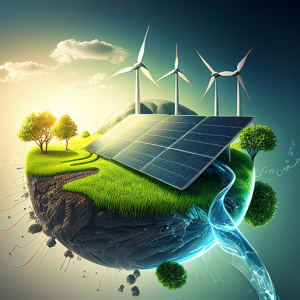
Renewable Sources of Energy
Renewable energy derives from sources that are naturally replenished and have a minimal environmental impact. These sources offer a sustainable alternative to fossil fuels, reducing greenhouse gas emissions and dependence on finite resources.
Solar Energy
Solar energy harnesses the power of the sun through photovoltaic cells to convert sunlight into electricity. As one of the most abundant renewable resources, solar energy has experienced rapid advancements in technology and affordability. Solar panels can be installed on rooftops or in solar farms, providing a decentralized and clean energy source for homes, businesses, and communities.
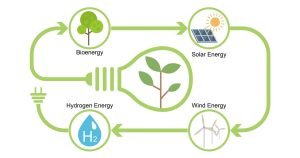
Wind Energy
Wind energy harnesses the kinetic energy of the wind to generate electricity through wind turbines. Wind farms, both onshore and offshore, are becoming increasingly prevalent as a cost-effective and scalable clean energy solution. Wind power is a versatile resource, suitable for various geographic regions, and can contribute significantly to the energy mix.
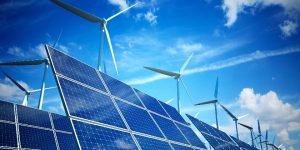
Hydropower
Hydropower generates electricity by capturing the energy of moving water in dams or river systems. It is one of the oldest forms of renewable energy and remains a reliable and consistent source of electricity. While large-scale hydropower projects have faced criticism due to their environmental impacts, small-scale and low-impact hydropower systems are being explored as sustainable alternatives
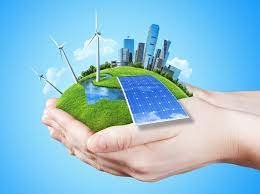
Geothermal Energy
Geothermal energy utilizes the Earth’s internal heat to generate electricity or provide heating and cooling for buildings. Geothermal power plants tap into natural reservoirs of hot water and steam beneath the Earth’s surface, offering a consistent and reliable energy source with low greenhouse gas emissions.
Sustainable Technologies
Beyond renewable energy sources, sustainable technologies play a vital role in maximizing energy efficiency, reducing waste, and mitigating the environmental impact of human activities.
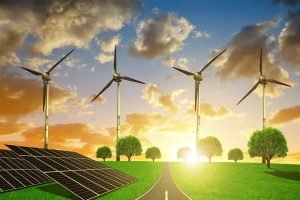
Energy Storage Solutions
The intermittency of some renewable energy sources, like solar and wind, necessitates efficient energy storage solutions. Battery technologies are rapidly advancing, enabling the storage of excess energy during peak production for use during low production periods. Energy storage systems contribute to grid stability, enabling a smoother integration of renewables into the energy infrastructure.
Smart Grids
Smart grids are intelligent electricity distribution networks that use data and communication technologies to optimize energy delivery and consumption. These grids facilitate real-time monitoring, enable demand-response mechanisms, and enhance grid reliability, making energy systems more resilient and efficient.
Electric Vehicles (EVs)
Transportation is a significant contributor to greenhouse gas emissions. Electric vehicles, powered by electricity from renewable sources, offer a cleaner and more sustainable mode of transportation. As EV technology advances and charging infrastructure expands, the widespread adoption of electric vehicles will contribute to reducing carbon emissions and improving air quality.

Energy-Efficient Buildings
Energy-efficient buildings utilize sustainable design, materials, and technologies to reduce energy consumption and greenhouse gas emissions. Passive design principles, efficient insulation, energy-efficient appliances, and smart building management systems all contribute to creating low-energy and environmentally friendly structures.
The sustainability of the energy sectors in developed and developing nations alike depends on the widespread usage of renewable energy.

Three fundamental factors make renewable energy sources and technologies a crucial part of sustainable development
Compared to other energy sources, they often have less of an influence on the environment. The variety of renewable energy sources offers a wide range of adaptable usage possibilities.
They can never run out. Renewable energy sources can offer an almost endless supply of dependable and sustainable energy if employed correctly in the right applications. In contrast, the resources for fossil fuels and uranium are depleted via extraction and use.
To successfully transition to a clean energy future, collaboration between governments, industries, and individuals is crucial. Continued research, investment, and adoption of clean energy solutions will not only reduce our carbon footprint but also create new economic opportunities and a more sustainable world. By embracing renewable sources and sustainable technologies, we can pave the way for a cleaner, greener, and more prosperous future.



